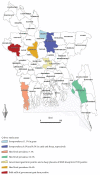Serological and Molecular Evidence of Q Fever in Domestic Ruminants in Bangladesh
- PMID: 27239369
- PMCID: PMC4867074
- DOI: 10.1155/2016/9098416
Serological and Molecular Evidence of Q Fever in Domestic Ruminants in Bangladesh
Abstract
The objective of this study was to know the herd and animal level prevalence of Q fever in domestic ruminants in some selected districts in Bangladesh. Randomly collected 111 bulk milk and 94 sera samples of cattle, sheep, and goats were tested by indirect ELISA (iELISA). DNA extracted from 23 aborted fetal membranes was analyzed by real time (rt) PCR. The positive cut-off value of iELISA in bulk milk and individual animal sera was ≥30% and ≥40%, respectively. The overall herd level prevalence of Q fever in dairy cattle was 15.6%. The prevalence of Q fever in dairy cattle was significantly higher in Sirajganj in comparison to Satkhira District (P < 0.01). The overall seroprevalence of Q fever in domestic ruminants was 5.06%. Although statistically insignificant, the seroprevalence of Q fever was relatively higher in sheep (9.52%) in comparison to goats (3.33%) and cattle (3.57%). Out of 23 aborted fetal membranes, only one sheep placenta was positive in rt PCR. Q fever is present in all of the three important species of domestic ruminants in Bangladesh. It may have some role in sheep abortion as the seroprevalence is relatively higher and also one sheep placenta is rt PCR positive.
Similar articles
-
Occurrence and risk factors of Coxiella burnetii in domestic ruminants in Lebanon.Comp Immunol Microbiol Infect Dis. 2019 Jun;64:109-116. doi: 10.1016/j.cimid.2019.03.003. Epub 2019 Mar 8. Comp Immunol Microbiol Infect Dis. 2019. PMID: 31174685
-
Seroprevalence of Toxoplasma gondii infection in ruminants in selected districts in Bangladesh.Vet Parasitol Reg Stud Reports. 2018 Jan;11:1-5. doi: 10.1016/j.vprsr.2017.10.008. Epub 2017 Nov 2. Vet Parasitol Reg Stud Reports. 2018. PMID: 31014609
-
Coxiella burnetii in bulk tank milk samples from dairy goat and dairy sheep farms in The Netherlands in 2008.Vet Rec. 2012 Mar 24;170(12):310. doi: 10.1136/vr.100304. Epub 2012 Feb 20. Vet Rec. 2012. PMID: 22351793
-
Q fever and seroprevalence of Coxiella burnetii in domestic ruminants.Vet Ital. 2018 Dec 31;54(4):265-279. doi: 10.12834/VetIt.1113.6046.3. Vet Ital. 2018. PMID: 30681125 Review.
-
[Coxiella burnetii: what is the reality?].Parassitologia. 2004 Jun;46(1-2):131-4. Parassitologia. 2004. PMID: 15305702 Review. Italian.
Cited by
-
Seroprevalence of Q fever among human and animal in Iran; A systematic review and meta-analysis.PLoS Negl Trop Dis. 2017 Apr 10;11(4):e0005521. doi: 10.1371/journal.pntd.0005521. eCollection 2017 Apr. PLoS Negl Trop Dis. 2017. PMID: 28394889 Free PMC article.
-
Sero-Epidemiology of Coxiella burnetii Infection in Small Ruminants in the Eastern Region of Punjab, Pakistan.Pathogens. 2022 Jun 8;11(6):664. doi: 10.3390/pathogens11060664. Pathogens. 2022. PMID: 35745517 Free PMC article.
-
Global and regional seroprevalence of coxiellosis in small ruminants: A systematic review and meta-analysis.Vet Med Sci. 2024 May;10(3):e1441. doi: 10.1002/vms3.1441. Vet Med Sci. 2024. PMID: 38613179 Free PMC article.
-
Serospatial epidemiology of zoonotic Coxiella burnetii in a cross section of cattle and small ruminants in northern Nigeria.PLoS One. 2020 Oct 19;15(10):e0240249. doi: 10.1371/journal.pone.0240249. eCollection 2020. PLoS One. 2020. PMID: 33075103 Free PMC article.
-
Seroprevalence of brucellosis and Q fever (Coxiellosis) in cattle herds in Maigana and Birnin Gwari agro-ecological zone of Kaduna State, Nigeria.Trop Anim Health Prod. 2018 Oct;50(7):1583-1589. doi: 10.1007/s11250-018-1598-3. Epub 2018 Apr 19. Trop Anim Health Prod. 2018. PMID: 29675780
References
-
- Babudieri B. Q fever: a zoonosis. Advances in Veterinary Science. 1959;5:81–182.
LinkOut - more resources
Full Text Sources
Other Literature Sources


